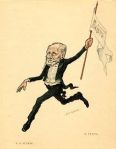Ballet in one act
Music by Cesare Pugni
Libretto by Arthur Saint-Léon
World Première
23rd May 1844
Her Majesty’s Theatre, London
Choreography by Arthur Saint-Léon and Fanny Cerrito
Original 1844 Cast
Kathi
Fanny Cerrito
Hans
Arthur Saint-Léon
Saint Petersburg Première
25th December [O.S. 13th December] 1855
Imperial Bolshoi Kamenny Theatre
Original 1855 Cast
Kathi
Maria Surovshchikova-Petipa
Hans
Jules Perrot
Première of Petipa’s revival
20th October [O.S. 8th October] 1881
Imperial Mariinsky Theatre
Original 1881 Cast
Kathi
Ekaterina Vazem
Hans
Pavel Gerdt
The First Postman
Lev Ivanov
The Hungarian Count
Felix Kschessinsky
The Hungarian Countess
Liubov Savitskaya
Plot
In a Hungarian village, Kathi, a regimental vivandière, is in love with Hans, the son of the innkeeper. However, the local mayor has also set his sights on Kathi and seeks to hinder the young couple from being together. The adventures of the charming girl and her beloved form the plot.

History
La Vivandière was a ballet created that marked the beginning of one of the most celebrated partnerships of the nineteenth century – Arthur Saint-Léon and Fanny Cerrito. Cerrito was among the greats of the Romantic Era ballerinas and Saint-Léon was her male counterpart. Despite the policies of the time that ensured male dancing was more than less tolerated, Saint-Léon fought and conquered these prejudices with his outstanding dancing abilities. Saint-Léon and Cerrito met during his season in London in 1843 and a professional partnership and a personal relationship between the two shortly began. They were married in Paris in 1845, but later separated in 1851. From their professional partnership, several new works and restagings would emerge and the first was La Vivandière, which seems to have been a joint creation between Saint-Léon and Cerrito. The year before, in 1843, Saint-Léon had staged an earlier version of the ballet in Rome, with the choreography credited to him, and when the finalised version was staged in London, the choreography was credited to Cerrito.
In the definitive version, Saint-Léon and Cerrito expanded the ballet to add a new polka number entitled the Redowa, or Original Polka of Bohemia. The reason behind this decision was due to the growing popularity of the polka dance in London at the time and this new polka proved to be more successful and popular than any other version that had been presented on the London stage so far. La Vivandière made its world première on the 23rd May 1844 at Her Majesty’s Theatre and was a huge success. The ballet would be performed again in 1845, 1846 and 1848 and made its première in Paris on the 20th October 1848.

La Vivandière in Russia
Four years after Saint-Léon and Cerrito separated, La Vivandière was brought to Russia by Jules Perrot. Perrot’s production premièred on the 25th December [O.S. 13th December] 1855 under the title Markitantka, with Maria Surovchshikova-Petipa as Kathi and Perrot as Hans. The following year, on the 7th September [O.S. 26th August] 1856, Alexander II was crowned Tsar of Russia and in accordance with tradition, a series of gala performances of opera and ballet was held in Moscow to celebrate the occasion. The artists participating were singers and dancers from both Moscow and Saint Petersburg and among those chosen from Saint Petersburg were Petipa, Maria Surovchshikova-Petipa, Perrot, Chrisitan Johansson and Pierre Frédéric Malvergne. The ballets that were performed were Perrot’s Gazelda, or The Gypsy, in which the Petipas danced, and La Vivandière, or Markitantka, which starred Fanny Cerrito in her original role, alongside Perrot as Hans, Frédéric and Johansson and was performed on the 12th September [O.S. 30th August] 1856 at the Bolshoi Theatre. Petipa later revived Markitantka for Ekaterina Vazem; his revival premièred on the 20th October [O.S. 8th October] 1881, with Vazem as Kathi and Pavel Gerdt as Hans.

La Vivandière Pas de six
The most famous piece of La Vivandière is what is commonly known as the La Vivandière Pas de six. This pas de six was originally a pas de quatre that Fanny Cerrito performed and was possibly created for the ballet Le Lac des fées in her first season at Her Majesty’s Theatre in 1840. Saint-Léon later transferred this pas de quatre into La Vivandière for the ballet’s Paris production and expanded it into a pas de six. The La Vivandière Pas de six became one of the most celebrated passages from the ballet and Saint-Léon fully notated it in his own system of dance notation and it was published in his book La Sténochorégraphie in 1852. In 1975, the La Vivandière Pas de six was reconstructed by dance notation expert Ann Hutchinson-Guest and Pierre Lacotte for the Joffery Ballet and in 1978, Lacotte staged the pas de six for the Kirov/Mariinsky Ballet. Since then, the La Vivandière Pas de six has been performed by companies all over the world.
Sources
- Guest, Ivor (1954) The Romantic Ballet in England. Hampshire, UK: 2014 ed. Dance Books Ltd
- Meisner, Nadine (2019) Marius Petipa, The Emperor’s Ballet Master. New York City, US: Oxford University Press
Photos and images: © Dansmuseet, Stockholm © Большой театр России © Victoria and Albert Museum, London © Государственный академический Мариинский театр © CNCS/Pascal François © Bibliothèque nationale de France © Musée l’Opéra © Colette Masson/Roger-Viollet © АРБ имени А. Я. Вагановой © Михаил Логвинов © Михайловский театр, фотограф Стас Левшин. Партнёры проекта: СПбГБУК «Санкт-Петербургская государственная Театральная библиотека». ФГБОУВО «Академия русского балета имени А. Я. Вагановой» СПбГБУК «Михайловский театр». Михаил Логвинов, фотограф. Martine Kahane.
